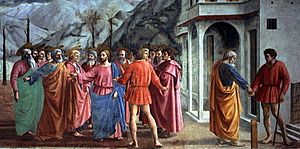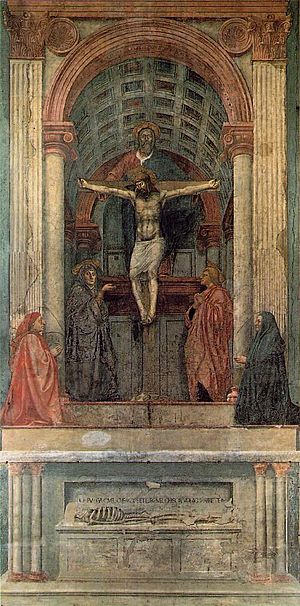Masaccio facts for kids
Tommaso Guidi, known as Masaccio (born in 1401 and died in 1428), was a famous painter from the Italian Renaissance. He worked in Florence. His nickname, Masaccio, meant Fat Untidy Tom.
Masaccio lived a very short life. Only a few of his paintings still exist. However, his art was very different from other artists of his time. His unique style helped other painters see things in a new way.
Contents
Masaccio's Life Story
Early Life and Training
Masaccio was born on December 21, 1401. His hometown was San Giovanni Valdarno, near Florence. His father was a notary, someone who writes legal documents.
Masaccio's older brother also became a painter. He moved to Florence to work in a painter's workshop. It is thought that Masaccio might have trained there too. His brother was nicknamed Lo Scheggia, meaning The Splinter. This suggests he was very thin, unlike Masaccio.
In 1422, when Masaccio was 21, he was already known as a painter. He joined the Company of Saint Luke. This was a group that helped artists and set rules for their work.
First Known Painting
Masaccio's earliest known painting is the San Giovenale Triptych. It was painted in 1422. A "triptych" is a painting made of three parts. They were often used as altarpieces in churches.
This altarpiece shows the Virgin Mary and Christ Child sitting on a throne in the middle. The side panels show two saints on each side. Two small angels kneel in front of the Virgin Mary. What makes this painting special is that the angels are shown from the back. This invites the viewer to feel part of the scene. Masaccio often used this trick in his art.
The Baby Jesus looks plump and serious. The figures look three-dimensional, almost like statues. There isn't much fancy decoration. This style was very different from other paintings of that time. Most art then was in a style called International Gothic, which was much more decorative.
Painting Real People
In April 1422, a new church opened in Florence. There was a big celebration. The church was Santa Maria del Carmine. Masaccio went with his friends: the sculptor Donatello, the architect Brunelleschi, and the painter Masolino.
After the celebration, Masaccio likely went to Rome with his friends. Brunelleschi and Donatello loved exploring the ruins of Ancient Rome. Masaccio also spent time looking at these old ruins. He saw sculptures that were more lifelike than anything he had seen before. Many sculptures showed groups of people. Each person looked different and real.
When Masaccio returned to Florence, he got a job. He was asked to paint a fresco of the procession he had seen. A fresco is a painting done on wet plaster. Masaccio was inspired by the sculptures he saw in Rome.
A writer named Vasari saw this painting before it was destroyed. He wrote that the people in the fresco were in rows, five or six deep. They were all different: fat, thin, tall, short. Some wore long cloaks, others big hats. Every person was a portrait of a real person from Florence. Masaccio even included his friends Brunelleschi, Donatello, and Masolino in the picture. Luckily, some artists drew parts of the painting before it was lost.
Working with Masolino
At the Uffizi Gallery in Florence, there is an altarpiece. It shows the Madonna and Child with Saint Anne. The Virgin Mary and Jesus sit on a throne. Saint Anne, Mary's mother, stands behind Mary. She has one hand on Mary's shoulder and blesses Baby Jesus with the other. This painting might have been made for a convent of nuns who honored Saint Anne.
Art experts believe two artists worked on this painting together. They think Masaccio painted Mary, Jesus, and the angel near the top right. They believe Saint Anne and the other four angels were painted by Masolino.
Masolino was 17 years older than Masaccio. His real name was Tommaso da Panicale. When they worked together, they became known as Masaccio and Masolino. Masolino means "Little Tom." These are the names we remember them by.
The Brancacci Chapel Paintings
Teamwork on the Chapel
The Brancacci Chapel is a large chapel in the Church of Santa Maria del Carmine. This is where Masaccio had painted the procession earlier. The Brancacci family paid for its decoration. We don't have records, but it seems Masaccio and Masolino got the job together.
The work probably started around 1423 or 1424. The plan was to show how Sin entered the world. This happened when Adam and Eve disobeyed God. Masolino painted them taking fruit from the forbidden tree. Opposite this, Masaccio painted Adam and Eve being chased out of the Garden of Eden. The rest of the paintings show The Life of Saint Peter. Saint Peter was important to the Catholic Church. The paintings showed that God's love comes through the Church.
Masaccio and Masolino planned the frescoes together. Their styles were different, but they looked good side-by-side. Masolino's paintings were prettier and more elegant. Masaccio's figures looked strong and solid, like the statues he saw in Rome. His figures looked very three-dimensional. He was inspired by Giotto, an artist who worked in Florence almost a hundred years before.
One of Masaccio's most famous paintings here is The Tribute Money. This large picture shows mountains, a lake, and a town like Florence. There are three parts to the story. In the middle, Jesus and his twelve disciples meet a tax collector. They have no money. Jesus tells Peter to go fishing. Peter looks annoyed. On the left, Peter kneels by the lake with a fish. Inside the fish is a coin. On the right, Peter gives the coin to the tax collector. He looks humble now. Masaccio showed their feelings through their faces and body language.
Masaccio and Masolino often had other jobs, so they couldn't work on the frescoes all the time. In 1428, Masaccio went to Rome. He was asked to paint an altarpiece for a very important church, Santa Maria Maggiore. He only painted one part, Saint Jerome and Saint John the Baptist, before he died at age 27. Masolino and another artist finished the altarpiece. It was later broken up, and parts are now in different galleries. Masaccio's panel is in the National Gallery, London.
Masolino lived for 19 more years but never finished the Brancacci frescoes. The Brancacci family got into trouble and were forced to leave Florence. One of Masaccio's pictures was damaged because it showed members of the Brancacci family. About 50 years later, in the 1480s, Filippino Lippi finished the missing parts. He tried to paint in the styles of Masaccio and Masolino.
Damage to the Chapel
The chapel was first dedicated to Saint Peter. Later, it was rededicated to Our Lady of the Common People. A beautiful old altarpiece was placed there. People believed this image of the Virgin Mary could work miracles. Hundreds of candles were lit in front of it, which stained the frescoes. Their bright colors became hard to see. The painting was moved to another church.
Later, part of the roof fell in and had to be fixed. More damage happened during redecorating. In 1680, a nobleman wanted to tear down the paintings because they seemed old-fashioned. Luckily, the Grand Duchess Vittoria della Rovere stopped him. In 1734, a painter cleaned the frescoes. Then, in the 1770s, a fire in the church caused more staining and damage.
New Discoveries
In recent years, four interesting things have been found. In 1904, during a small cleaning, two marble slabs near the altar were moved. Underneath them were bright colors, showing how the frescoes originally looked. Experts also found plans for two destroyed paintings where windows had been changed. Finally, two painted roundels (small round pictures) were found in the chapel. They had little angel faces, one by Masaccio and one by Masolino.
Art historians had a puzzle. A scene was missing from the story of Saint Peter. It was the part where Jesus says, "You are Peter, and on this Rock I build my Church." This part is very important to the Roman Catholic Church. Peter was the first Bishop of Rome, and the Pope is seen as his direct successor. This scene is usually shown with Jesus giving Peter the Keys of Heaven. The Keys have been a symbol of the Pope for hundreds of years. But this story was completely missing from the chapel.
Then, in the 1940s, John Pope-Hennessy, director of the Victoria and Albert Museum in London, realized something. His museum owned a work of art that was exactly what was missing! It was a thin, flat marble slab. It was carved with the scene of Jesus giving the Keys to Peter. It was the right size to be the front of an altar. Even though it couldn't be fully proven, it was almost certainly carved by Masaccio's friend, Donatello.
The Trinity Painting
While working on the Brancacci Chapel, Masaccio also painted a fresco for another church in Florence. This was Santa Maria Novella, a church of the Dominican Order. This painting, called The Trinity, is very special and one of Masaccio's most famous works.
It shows the Holy Trinity, which means God in three parts. God is shown as the eternal Creator, as Jesus on the Cross (a humble Sacrifice), and as the inspiring Spirit. The Virgin Mary and Saint John stand on either side of the Cross. Two kneeling figures are the family who paid for the painting.
Masaccio painted this holy scene as if it were happening in a deep space or a small chapel in the church wall. He did this using very accurate perspective. It is believed that the architect Brunelleschi might have helped him. The painted architecture looks very much like buildings Brunelleschi designed.
Masaccio's Influence
Vasari wrote that Masaccio was not very famous during his own time. In 1440, his body was brought to Florence and buried at Santa Maria del Carmine. No monument was built for him then. But soon after, people began to honor him as a great painter.
Later, famous artists like Michelangelo and many others went to the Brancacci Chapel. They studied Masaccio's paintings there. His style influenced artists like Fra Angelico, Piero della Francesca, Ghirlandaio, and especially Michelangelo.
- Giorgio Vasari, Lives of the Painters, translated by George Bull, Penguin Classics, ISBN: 0-14-044-164-6
- Ornella Casazza, Masaccio, Scala/Riverside, 1990, ISBN: 1-878351-11-7
Images for kids
-
When it was cleaned in the 1980s, Masaccio's fresco of The Expulsion (1426–1427) lost the added fig leaves.
-
Virgin Mary with pseudo-Arabic halo, by Masaccio (1426).
See also
 In Spanish: Masaccio para niños
In Spanish: Masaccio para niños








